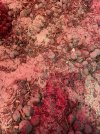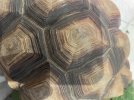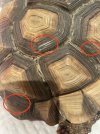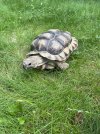Hi all,
I am worried about some recent observations. I will provide you as much information as possible to hopefully get as many helpful comments and replies.
1. General: Chaco, female, 28-30 years old. Lives in Scandinavia (outside during summer, inside during winter). (Picture 1).
2. Enclosure: Lived her whole life in open enclosures with access to livingroom. Enclosure substrate mix of sand and bark, typical repti bark (Picture 2). Seasonal added natural cut grass during summer / leafs during fall, etc. Recently added leca balls (will be removed during next substrate change). Approx 30 cm debth with homogenous substrate. The top 5 cm of the substrate is dry, then a stable moisture can be felt throughout the rest. Access to garden during summer including flat areas/steep hills/grass/rocks/woods/wild flowers etc.
3. Infra red heat lamp (ExoTerra) + Spiral UVB 150 desert bulb (ExoTerra). Bulbs 30 cm above substrate.
4.1. Diet: Summer: Natural greens (clovers, dandelion, fall fruits ++) + calcium when fed inside. Winter: store bought vegetables + home dried greens + calcium + dry formula (occacionally).
4.2. Additives: Repti Calcium with D3 (ZooMed). Tortoise dry formula (T-rex). Indoor food dish is a natural flat rock.
5. Health: Beak trimmed 4 times troughout her life, last trim 1 month ago at vet. Weight stable at 1,2 kg (2.4 lb) last 10 years. Deworming given once 10 years ago (no symptoms but found during fecal vet inspection). Eats and drinks several times troughout the day. Defecates every to every third day. Urinates approx every day. Full soaking bath 1-2 times a week, more often during summer. Walks with straight legs. Clear eyes, clear breathing. No mucus.
6. Behoviral: Reacts normal to hot/cold environment and day/night. Usually digs nests in her enclosure every day, all year around. Digs nests outside during summer. Lays unfertilized eggs without issues 1-3 times a year for the last 10 years. Sleeps with head and limbs outside of shell. "Social" behaviour, walks up to us and accepts cuddles to head, neck and front of shell.
7. Yes, I am aware of the pyramiding. Internet, reptile additives and equipment were not around 28 years ago and the library had a book about marine turtles. Not trying to make any excuses, I am more sorry about it than any of you.
Today she went up to a garden chair and started to frantically itch her front limbs and sides of her head against the chair. I have never seen her behave this way before. She has already lost some of the scutes on the tip of her nose, and several in the back of the head. A few of them are clearly loose when I touch them, most of them over her eyes. No lost scutes on her limbs.
Observation 2. During growth I have previously seen beige/white color in the lines between the shell scutes. They grow out and turn black (Picture 3). Recently I have noticed an increasing amount of this on the scutes back of the shell (Picture 4), also on the older parts of the scutes (see red circles, Picture 4). It doesn't come of by brushing and doesn't seem like natural wear and tear. It also feels like the groove on her scutes of the back of the shell is groving/getting deeper (Picture 4). Her plastron is stable and unchanged.
Questions: Will the scutes on her head grow out?
Am I looking at shell rot? What can I look for to confirm if it is shell rot or not? Any red flags with the set up or diet that may have caused the changes I am observing?
I was of the impression that she was done growing. Is she still growing and pyramiding?
She behaves normal othervise, but I am worried she may have nutrional lacks; Any knowledge about which blood samples should be examined that directly affects skin/shell health?
Any tips for further examinations?
Am I over reacting over natural behaviour...?
Other comments about the set-up and diet are more than welcome, but please specify if its related to my questions or not.
Thank you for your time!
I am worried about some recent observations. I will provide you as much information as possible to hopefully get as many helpful comments and replies.
1. General: Chaco, female, 28-30 years old. Lives in Scandinavia (outside during summer, inside during winter). (Picture 1).
2. Enclosure: Lived her whole life in open enclosures with access to livingroom. Enclosure substrate mix of sand and bark, typical repti bark (Picture 2). Seasonal added natural cut grass during summer / leafs during fall, etc. Recently added leca balls (will be removed during next substrate change). Approx 30 cm debth with homogenous substrate. The top 5 cm of the substrate is dry, then a stable moisture can be felt throughout the rest. Access to garden during summer including flat areas/steep hills/grass/rocks/woods/wild flowers etc.
3. Infra red heat lamp (ExoTerra) + Spiral UVB 150 desert bulb (ExoTerra). Bulbs 30 cm above substrate.
4.1. Diet: Summer: Natural greens (clovers, dandelion, fall fruits ++) + calcium when fed inside. Winter: store bought vegetables + home dried greens + calcium + dry formula (occacionally).
4.2. Additives: Repti Calcium with D3 (ZooMed). Tortoise dry formula (T-rex). Indoor food dish is a natural flat rock.
5. Health: Beak trimmed 4 times troughout her life, last trim 1 month ago at vet. Weight stable at 1,2 kg (2.4 lb) last 10 years. Deworming given once 10 years ago (no symptoms but found during fecal vet inspection). Eats and drinks several times troughout the day. Defecates every to every third day. Urinates approx every day. Full soaking bath 1-2 times a week, more often during summer. Walks with straight legs. Clear eyes, clear breathing. No mucus.
6. Behoviral: Reacts normal to hot/cold environment and day/night. Usually digs nests in her enclosure every day, all year around. Digs nests outside during summer. Lays unfertilized eggs without issues 1-3 times a year for the last 10 years. Sleeps with head and limbs outside of shell. "Social" behaviour, walks up to us and accepts cuddles to head, neck and front of shell.
7. Yes, I am aware of the pyramiding. Internet, reptile additives and equipment were not around 28 years ago and the library had a book about marine turtles. Not trying to make any excuses, I am more sorry about it than any of you.
Observation 1. During the last month she has started to shed/flake off some of the scutes on her head. She seems to be shedding but I have never, ever, seen this before.Today she went up to a garden chair and started to frantically itch her front limbs and sides of her head against the chair. I have never seen her behave this way before. She has already lost some of the scutes on the tip of her nose, and several in the back of the head. A few of them are clearly loose when I touch them, most of them over her eyes. No lost scutes on her limbs.
Observation 2. During growth I have previously seen beige/white color in the lines between the shell scutes. They grow out and turn black (Picture 3). Recently I have noticed an increasing amount of this on the scutes back of the shell (Picture 4), also on the older parts of the scutes (see red circles, Picture 4). It doesn't come of by brushing and doesn't seem like natural wear and tear. It also feels like the groove on her scutes of the back of the shell is groving/getting deeper (Picture 4). Her plastron is stable and unchanged.
Questions: Will the scutes on her head grow out?
Am I looking at shell rot? What can I look for to confirm if it is shell rot or not? Any red flags with the set up or diet that may have caused the changes I am observing?
I was of the impression that she was done growing. Is she still growing and pyramiding?
She behaves normal othervise, but I am worried she may have nutrional lacks; Any knowledge about which blood samples should be examined that directly affects skin/shell health?
Any tips for further examinations?
Am I over reacting over natural behaviour...?
Other comments about the set-up and diet are more than welcome, but please specify if its related to my questions or not.
Thank you for your time!






